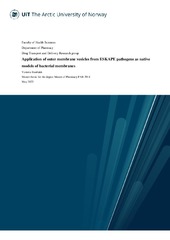Application of outer membrane vesicles from ESKAPE pathogens as native models of bacterial membranes
Permanent link
https://hdl.handle.net/10037/37064Date
2023-05-14Type
MastergradsoppgaveMaster thesis
Author
Stenbakk, VictoriaAbstract
The antimicrobial resistance crisis has led to the emergence of multidrug-resistant pathogens, posing a significant threat to public health. To address this crisis there is an ongoing search for new antimicrobial substances. To facilitate this search and to understand the nature of antimicrobial resistance better it is crucial to develop representative models of bacterial membranes and efficient methods for characterizing the interaction mechanisms of novel antimicrobials. One promising model system is outer membrane vesicles (OMVs), which are naturally secreted by Gram-negative bacteria and play various roles in communication, virulence, molecular transport, and antimicrobial resistance mechanisms. Due to their origin from the outer membrane, the OMVs inherent many of the properties and characteristics from the outer cell envelope.
We isolated OMVs from Gram-negative strains of the ESKAPE pathogens: Klebsiella pneumoniae, Acinetobacter baumannii and Pseudomonas aeruginosa. To characterize the vesicles, transmission electron microscopy (TEM), size and zeta-potential measurements were used, and 31P NMR and MS were used to investigate the lipid composition. Interaction between the vesicles and hexameric Lysine- or Arginine and Tryptophan-rich cyclic antimicrobial peptides (AMPs) was studied using Surface Plasmon Resonance (SPR).
Isolated OMVs from tested strains had their own particularities. OMVs from P. aeruginosa had the least negative zeta-potential. K. pneumoniae demonstrated more diverse lipidome with presence of atypical lipids comparing to others. Common for all is the PE lipid being the dominant lipid class, with CL and PG present at lower levels. SPR analysis revealed differences in interaction of AMPs in terms of kinetic rates. Overall binding patterns were similar for the three pathogens, where AMPs with “clumped” amino acids demonstrated the strongest binding. Interestingly, no correlation between the binding and antimicrobial activity was observed.
Our study demonstrated that OMVs can serve as a practical and realistic model for studying bacterial surface interactions. More thorough studies of resistance mechanisms and mechanisms of antimicrobial activity using OMVs and SPR technique are now possible.
Publisher
UiT Norges arktiske universitetUiT The Arctic University of Norway
Metadata
Show full item recordCollections
Copyright 2023 The Author(s)
The following license file are associated with this item:


 English
English norsk
norsk
